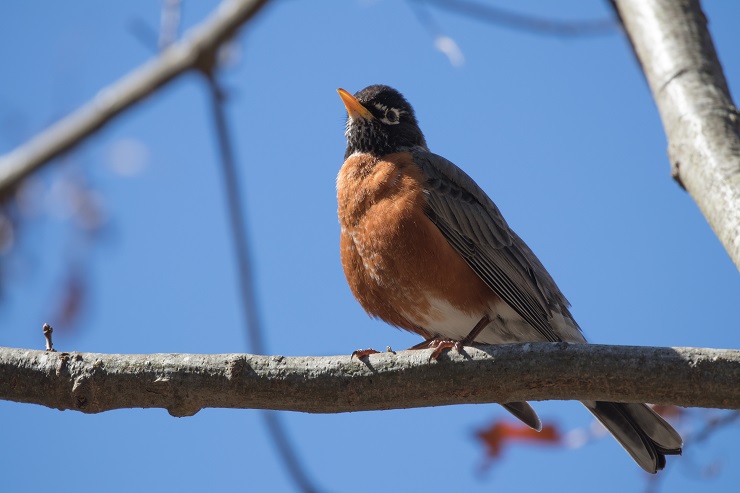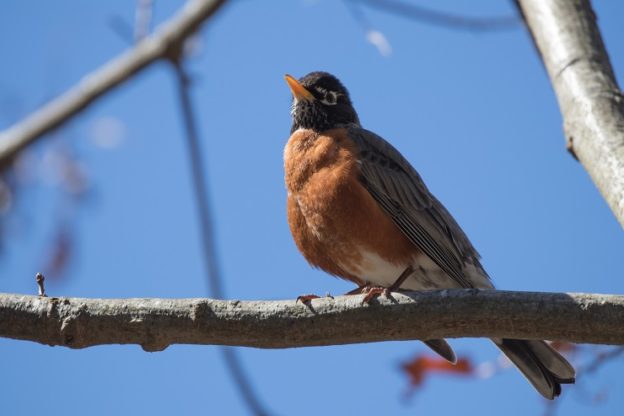
As buds bloom and seedlings sprout, you can hear the familiar chorus of American Robins in your backyard, signaling the arrival of spring. Over the last few years, however, you may have heard our robins start singing earlier than usual.
What We Know
A recent study found that migrating American Robins now start their journeys about 12 days earlier than they did in 1994 because of climate change’s impacts on temperature and weather.
Robins can be seen near year-round in the US, and since the 1900s have been sighted in Massachusetts during the winter. However, most American Robins migrate from wintering habitats to breeding habitats in response to food availability. These migrations can span as far as from Central America in the winter to throughout the US and even into Canada in spring and summer.
To track the south to north migratory patterns of these hallmark birds from Alberta, Canada to throughout Alaska between 1994-2018, scientists outfitted a group of migrating American Robins with small GPS harnesses. They found that environmental cues affected robin migration. Namely, snow and temperature were among the strongest influences: during drier and warmer winters, robins would migrate earlier than normal.
Study results suggest robins have been migrating five days earlier every decade since 1994 (for a total of about 12 days), indicating a response to warming temperatures.
What this tells us About Climate Change
One of climate change’s impacts is higher average temperatures and shorter, milder winters. American robin’s early arrival, even in New England, is just one way we can see climate change impacting our wildlife, here and now with increasing intensity.
According to Mass Audubon’s 2017 State of the Birds report, warmer winters shift the way critical food webs work and warmer overall temperatures influence the timing of ecological events – like when leaves and insects pop out for spring.
Such changes can lead to climate change induced food shortages and missed foraging or predation opportunities. Climate change’s impacts cascade through the environment, reflecting on species like the American Robin down to the availability of the food they eat, such as earthworms. But we can help!
Making a Difference Together
American Robins sing an important tale about climate change’s impacts – it’s up to us to listen and learn.
To support our wildlife, we must fight climate change at its source by reducing and eliminating excess greenhouse gas emissions. Join our collective climate fight by signing up for our newsletter, Climate Connection, to stay up to date on how to act on climate as a community .
You can also take our climate pledge to commit to reducing your greenhouse gas emissions both individually and as a community or make a gift to Mass Audubon to support our climate action initiatives.
When we act together, we can fight climate change to protect the world around us and the wildlife we love.
If you want to learn more about American Robins during your climate action journey, check out Mass Audubon’s “Bird of the Day” with Joan Walsh, Gerard A. Bertrand Chair of Natural History and Field Ornithology



Thoughtful and well-written.
Now I feel guilty that I felt happy when I saw robins end of February. Knowledge is everything. Thank you for writing this.
Great article I have American Robins outside my windows never realized that the climate impacted their migration thanks Rishya N for the insight
Great points! You are right – it’s up to us to listen and learn. These signal have substantial impacts on our ecosystem. Thanks for sharing.
Really well written. Informative, concise and makes its point.
Pithy and interesting!
I have had what I think is a great blue heron in my yard for two days (Ryans’s Way abutting the State Forest) and want to send someone a photo…can you help?
You can email our wildlife info line at wildlifeinfo at massaudubon dot org.